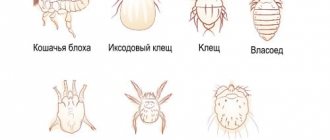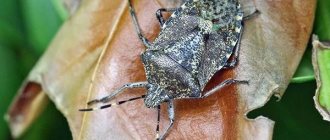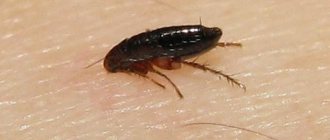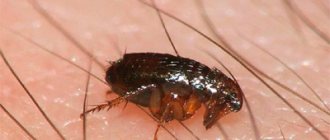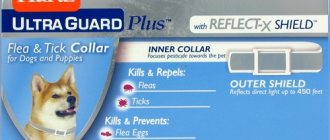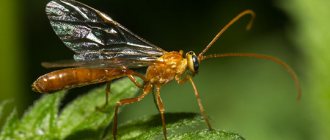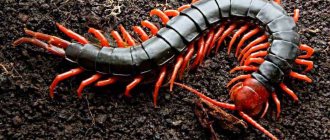Symptoms of fleas
- The main and most pronounced symptom is itching , which is characterized by varying degrees of intensity. Depending on the number of fleas on one animal, the itching may be mild.
- The second most important symptom is the formation of specific papules , and intensive scratching most often provokes the formation of scabs .
Itching is the first symptom of fleas in a ferret.
- With a significant number of ectoparasites, the animal may experience areas of varying sizes with characteristic baldness . A secondary sign confirming the presence of fleas in a domestic ferret is increased excitability and irritability of the animal.
- The diagnosis is made not only on the basis of external symptoms. One of the most reliable confirmations of the presence of parasites is the results of a study of scrapings, which are taken from the affected skin areas and confirm the conclusions of a therapeutic examination.
With a significant number of ectoparasites, the animal may have areas of varying sizes with characteristic baldness
Routes of infection
Flea infestation is a very common problem in domestic ferrets. Small parasitic insects easily settle on ferrets, especially if the animal has previously been in contact with flea-infested cats, dogs or any other animals. You can learn about ways to detect and destroy fleas on a cat by reading the corresponding article on our website.
In addition to the method of infection from animals already infected with ectoparasites, ferrets can acquire fleas from the external environment. Quite often, flea infestation is observed after visiting places where these blood-sucking insects live or breed.
In addition to the method of infection from animals already infected with ectoparasites, ferrets can acquire fleas from the external environment
Parasitosis caused by fleas in ferrets may not appear immediately. It should be borne in mind that these insects spend only a certain part of their life on ferrets, and the main habitat is the environment where ectoparasites carry out oviposition.
Stomach ulcer in a ferret
The ferret's digestive organs contain a large number of Helicobacter-type bacteria. They actively multiply and infect the gastric mucosa. The condition of the animal is worsened by an irrationally formulated diet and frequent stress. In severe cases, the ulcer leads to massive bleeding and death.
Symptoms in a ferret do not appear immediately; they are most often accompanied only by grinding of teeth, which occurs due to pain. The feces then become dark in color due to the large amount of blood in them. Sometimes vomiting and diarrhea occur. The ferret should be treated with antibiotics, proper nutrition, and sometimes enzymes are prescribed. In case of bleeding, urgent surgical intervention is performed. After suffering a disorder, the animal will need a diet developed by a veterinarian for the rest of its life.
Ferrets are susceptible to stomach ulcers
Ferrets are animals with a playful character, but not always good immunity. The owner of a pet is obliged to take full care of the animal in order to prevent severe damage to the body. At the same time, we must not forget about our own safety; it is advisable to carry out the necessary vaccinations of the ferret, which will allow the pet to live normally, and will also prevent others from contracting dangerous diseases.
Harm to the animal
- Fleas parasitize ferrets regardless of the sex and age of the animal. Ferrets infected with parasites will bite, lick or scratch themselves. And if at the beginning of infection, external manifestations are almost completely absent, and the animal does not experience a feeling of discomfort, then the number of insects increases.
- Fleas are capable of leaving their fecal excretions on the skin of the ferret, as well as among its hair, which makes the appearance of the animal less healthy and presentable.
- A severe degree of infestation is characterized not only by the development of symptoms of anemia, but also contributes to slower growth and a significant deterioration in the quality of fur. Such manifestations are especially noticeable in the fragile bodies of young ferrets.
The result of numerous bites is the development of anemia in the ferret.
- Subtle bite marks are red in color, and the resulting ulcers are visible to the naked eye. Such violations of the integrity of the skin contribute to the development of a secondary bacterial infection.
- If the number of blood-sucking insects is significant, then the result of numerous bites is the development of anemia in the animal, which manifests itself in lethargy, apathy, decreased appetite and increased fatigue. Anemia is a rather serious disease and requires immediate treatment.
Ferret diseases
Diseases of domestic ferrets can be divided into contagious and non-contagious.
We will not describe all possible diseases of ferrets, but will touch on the most common and most dangerous to their lives. What diseases can a ferret suffer?
Rabies
in ferrets it is possible in the same way as in other domestic animals. The rabies virus causes severe damage to the central nervous system. The virus is transmitted through saliva and through a bite from an infected animal. A ferret can infect you with rabies if it bites you while it is infected. The incubation period lasts from 2 weeks to 3 months. There is no treatment for this. The animal is euthanized. Prevention - vaccination.
Plague
It is also a very dangerous disease; the sources of infection are sick animals or those who have recently suffered from the disease. The incubation period is 7-21 days. The presence of conjunctivitis, discharge from the eyes, fever, purulent discharge from the nose, redness of the skin around the eyes, nose, anus and the appearance of crusts on them, as well as loss of appetite, vomiting, diarrhea, weight loss - all these are signs of plague. The disease is difficult to treat, so the most important thing for effective treatment is to recognize the disease at an early stage. Prevention - annual vaccination.
Aleutian disease
- a viral disease that attacks the immune system. It is transmitted by contact and airborne droplets, as well as through contaminated objects. The incubation period is 6-150 days. Signs: sudden weight loss, fever, thirst, anemia, diarrhea, apathy, low mobility, lack of shedding with dull and tousled coat. An accurate diagnosis can be very difficult to make, often only established posthumously, and there is still no vaccine for this disease. Fortunately, the disease is not that common.
Flu
Ferrets are the only pets that can become infected with the flu from their owner. In this case, standard symptoms are observed: runny nose, lacrimation, sneezing, cough, fever. If a ferret puppy gets sick, it may die. Treatment is carried out using antibiotics and antihistamines.
Parasitic diseases
in ferrets are caused by various parasites in the form of fleas, ticks, and helminths. The variety of these diseases is great. The main thing in this matter is prevention. It is necessary to carry out antihelminthic treatment on a periodic basis, bathe the ferret with special antiparasitic shampoos and use special aerosols to protect against parasites. It is especially necessary to combat parasites in the spring and summer. A visit to the veterinarian at this time is mandatory; the specialist will prescribe the correct treatment and indicate the recommended drugs to combat parasites. It should be remembered that with very close contact with an animal there is a danger of parasite infection for people, especially children. You should not kiss the animal, you should wash your hands after contact with the animal, and do not allow the ferret to climb on the table where you eat food.
Ferret diseases are not contagious to humans and can affect various organs and organ systems.
Gastroenteritis
- a disease of the gastrointestinal tract that causes inflammation in the intestines. The cause of the disease is improper nutrition of the ferret. Read about proper nutrition for your ferret in the article “Feeding Ferrets.”
Avitaminosis and hypovitaminosis
– another type of disease caused by improper nutrition of a ferret. Signs of the disease vary depending on the type of vitamin, its deficiency or oversaturation of the body with this vitamin. The exact diagnosis and treatment is prescribed by a veterinarian.
Stomach ulcer
– another disease of the ferret’s gastrointestinal tract. Unfortunately, in the early stages it does not manifest itself in any way; with a more pronounced development of the disease, it manifests itself in loss of appetite, severe pain is observed, during which the ferret clenches his teeth, vomiting and diarrhea occur, and oily and black excrement appears. Ulcers are caused by an unbalanced diet, stress and pathogenic bacteria.
Ra hit
– the disease manifests itself in bone deformation caused by improper phosphorus-calcium metabolism in the ferret’s body. It is caused by an incorrect diet, and sometimes has a congenital character due to improper feeding of the female during pregnancy and feeding of puppies. There is poor appetite, disruption of the gastrointestinal tract, bloating, stunted growth, dull fur, skin loses elasticity, unnatural gait, weak paws spreading to the sides, and lameness. It is necessary to switch the animal to feeding on professional super-premium ferret food. Additionally, the veterinarian may prescribe calcium in the form of tablets, brewer's yeast, vitamins, spinal massage, exercise and swimming.
Urolithiasis disease
occurs for various reasons, including genetic predisposition, poor nutrition with an abundance of plant components in the feed, as well as untreated infectious diseases. Difficulty urinating, blood in the urine and general weakening of the ferret’s body appear. Treatment is medicinal and surgical.
Adrenal gland disease is caused by impaired secretion of sex hormones
. It is most often observed in ferrets aged 3 years and older. The cause of the disease has not been fully identified. Signs: loss of hair on the tail and body, apathy, weight loss. Castrated males may begin to mark their territory again, while uncastrated males may have problems with urination. Treatment is surgical.
Anemia
occurs in unsterilized females when there is no opportunity for mating. The female cannot come out of estrus on her own; this period drags on for months, while the female loses weight, loses appetite, the temperature rises, there is baldness of the tail and body, a depressed state, and the development of secondary bacterial diseases. All this leads to the death of the female. The article “Sterilization of Ferrets” outlines the reasons why it is necessary to sterilize ferrets if there is no opportunity for mating.
Cardiomyopathy
congestion is one of the most common diseases of the cardiovascular system of ferrets. This age-related disease manifests itself at the age of 5-7 years. Signs of the disease: difficulty breathing, decreased motor activity, weakness, dry cough, abdominal swelling. Diagnosed using x-rays and ECG. Unfortunately, there is no treatment, but the ferret’s condition is maintained with medication and a special diet.
Ferrets also exhibit various neoplasms and tumors; they are often benign and can be treated surgically.
As you age, problems with vision and hearing may occur. With cataracts, darkening of the lens of the eyes is observed, but blindness does not greatly affect the behavior of the ferret; they are perfectly oriented by smell and tactility, so even the owner may not realize that the ferret is blind.
In addition to various diseases, ferrets are also susceptible to injuries; how to provide first aid to a ferret, read our article “First aid for a ferret”
Ferrets have a variety of diseases, so be attentive to your pet. A healthy animal should have good shiny fur, a lively look, clear eyes, and a cold and moist nose. A healthy ferret is active, has a good appetite and a cheerful, playful mood. The ferret should be moderately well-fed. The stool has a normal appearance, without too much odor. Any changes in behavior and well-being are a reason to contact a veterinarian!
Treatment methods
If fleas are found on an animal, treatment should be started immediately. In addition, if you have other pets at home in addition to the ferret, you should check them for the presence of blood-sucking ectoparasites, and if any are found, carry out all the necessary therapeutic measures.
There are no specific products designed to kill fleas exclusively on ferrets. That is why veterinarians recommend using anti-flea drugs for dogs and cats to combat ectoparasites. Depending on the degree of development of the disease and the number of ectoparasites, the veterinarian will select the optimal drug that will help destroy blood-sucking insects with minimal harm to the animal. The most relevant and modern remedy today is the drug “Advantage” , designed to kill fleas in cats.
There are no specific products designed to kill fleas exclusively on ferrets. The most relevant and modern remedy today is the drug “Advantage”, developed to kill fleas in cats
A characteristic feature of fleas is that, depending on humidity and temperature conditions, ectoparasite larvae can remain viable in the environment for two to three weeks. It is for this reason that the use of anti-flea drugs should be combined with high-quality wet cleaning. It is recommended to thoroughly rinse the floors and treat all household items with water and special products. You can find out how to disinfect an apartment from fleas.
Please note that some medications are strictly prohibited for use on ferrets. These products include flea collars, as well as preparations containing phosphates. In addition, any preparations based on permethrin, regardless of the form of release, should not be used to kill fleas on ferrets.
Parasites in ferrets
The most common problems diagnosed in pets are fleas and ear mites. Infection with the first type of parasites occurs due to direct or indirect contact with other domestic animals, in particular dogs and cats. Fleas of human origin are often found on ferrets. When these parasites appear, they cause constant itching throughout the body. In addition, fleas are carriers of dangerous helminths that enter the animal’s body after a bite. The eggs quickly spread through the bloodstream to all tissues and organs. The main period for the appearance of fleas is summer and the warm months of spring and autumn.
Constant itching in a pet is a sign of fleas or ticks
Attention! In some ferrets, the appearance of fleas causes an acute allergic reaction. It is accompanied by severe itching, constant neurosis and the desire to itch. As a result, wounds appear on the animal’s body where bacteria can enter. It is not uncommon for ferrets to experience hair loss with this type of allergy.
Otodecotosis, another name for ear mites, is provoked by the influence of a carpet beetle mite. It actively multiplies in the area of the inner ear and external auditory canal. A person cannot suffer from this parasite, but he can become a carrier of the causative agent of otodecticosis to other pets. Infection with parasites also occurs through direct contact with a sick animal and through the use of common pet care items.
When ear mites appear, the animal’s skin suffers greatly, it is constantly irritated, and the ferret suffers from itching. At the same time, bacteria enter the wounds, causing suppuration and inflammation of the affected epidermis. Additionally, with otodecticosis, strong discharge from the ears is recorded, which is black in color and has an unpleasant odor.
You should constantly monitor the condition of the auricle for the presence of mites.
Attention! An ear mite diagnosis can be made after scraping and examining the material through a microscope.
Treatment of ear mites and fleas is carried out using the same means. One of the most effective of them is the drug in the form of drops Fiprist Combo. The medicine is sold in the form of a pipette, inside of which there is the active substance fipronil and S-methoprene. To rid your ferret of parasites, you need to carefully open the pipette and distribute the contents over the entire surface of the spine, starting from the back of the head. During the procedure, it is necessary to avoid getting liquid into the animal’s eyes. If necessary, the treatment procedure is carried out after a month.
Ferrets get fleas from other pets
Attention! To get the maximum effect, the animal is prohibited from bathing for 48 hours after applying Fiprist Combo.

